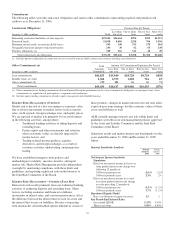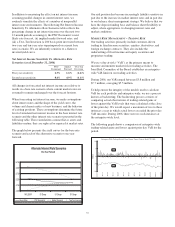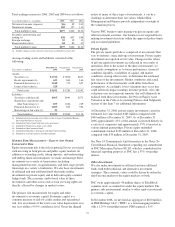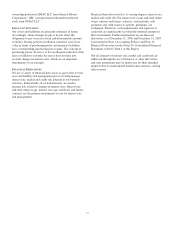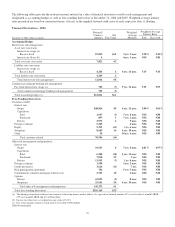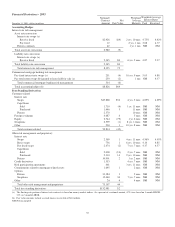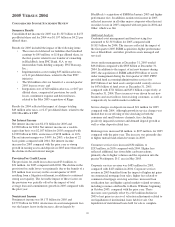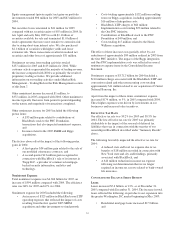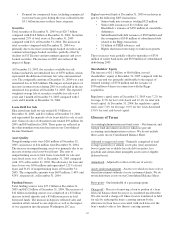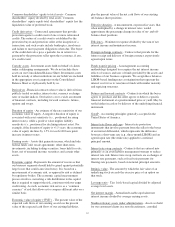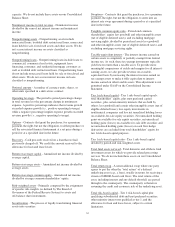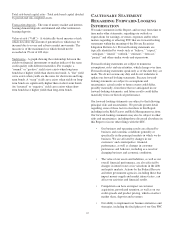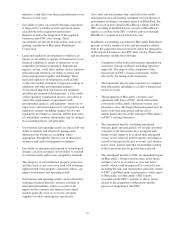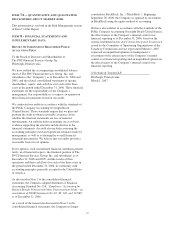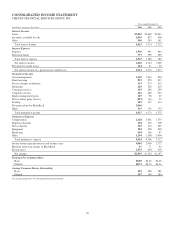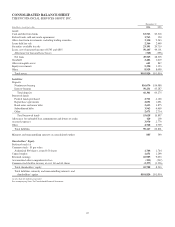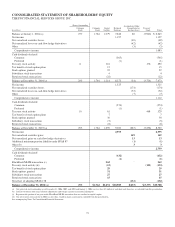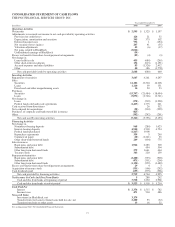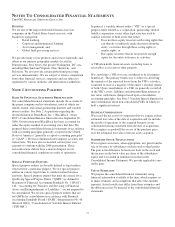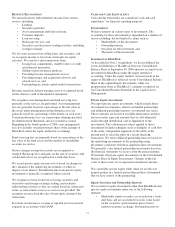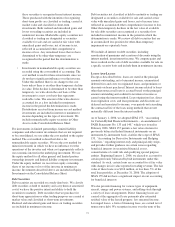PNC Bank 2006 Annual Report Download - page 74
Download and view the complete annual report
Please find page 74 of the 2006 PNC Bank annual report below. You can navigate through the pages in the report by either clicking on the pages listed below, or by using the keyword search tool below to find specific information within the annual report.
capacity. We do not include these assets on our Consolidated
Balance Sheet.
Noninterest income to total revenue - Noninterest income
divided by the sum of net interest income and noninterest
income.
Nonperforming assets - Nonperforming assets include
nonaccrual loans, troubled debt restructured loans, nonaccrual
loans held for sale, foreclosed assets and other assets. We do
not accrue interest income on assets classified as
nonperforming.
Nonperforming loans - Nonperforming loans include loans to
commercial, commercial real estate, equipment lease
financing, consumer, and residential mortgage customers as
well as troubled debt restructured loans. Nonperforming loans
do not include nonaccrual loans held for sale or foreclosed and
other assets. We do not accrue interest income on loans
classified as nonperforming.
Notional amount - A number of currency units, shares, or
other units specified in a derivatives contract.
Operating leverage - The period to period percentage change
in total revenue less the percentage change in noninterest
expense. A positive percentage indicates that revenue growth
exceeded expense growth (i.e., positive operating leverage)
while a negative percentage implies expense growth exceeded
revenue growth (i.e., negative operating leverage).
Options - Contracts that grant the purchaser, for a premium
payment, the right, but not the obligation, to either purchase or
sell the associated financial instrument at a set price during a
period or at a specified date in the future.
Recovery - Cash proceeds received on a loan that we had
previously charged off. We credit the amount received to the
allowance for loan and lease losses.
Return on average capital - Annualized net income divided by
average capital.
Return on average assets - Annualized net income divided by
average assets.
Return on average common equity - Annualized net income
divided by average common shareholders’ equity.
Risk-weighted assets - Primarily computed by the assignment
of specific risk-weights (as defined by The Board of
Governors of the Federal Reserve System) to assets and
off-balance sheet instruments.
Securitization - The process of legally transforming financial
assets into securities.
Swaptions - Contracts that grant the purchaser, for a premium
payment, the right, but not the obligation, to enter into an
interest rate swap agreement during a period or at a specified
date in the future.
Tangible common equity ratio - Period-end common
shareholders’ equity less goodwill and other intangible assets
(net of eligible deferred taxes), and excluding mortgage
servicing rights, divided by period-end assets less goodwill
and other intangible assets (net of eligible deferred taxes), and
excluding mortgage servicing rights.
Taxable-equivalent interest - The interest income earned on
certain assets is completely or partially exempt from federal
income tax. As such, these tax-exempt instruments typically
yield lower returns than a taxable asset. To provide more
meaningful comparisons of yields and margins for all interest-
earning assets, we also provide revenue on a taxable-
equivalent basis by increasing the interest income earned on
tax-exempt assets to make it fully equivalent to interest
income earned on other taxable assets. This adjustment is not
permitted under GAAP on the Consolidated Income
Statement.
Tier 1 risk-based capital - Tier 1 risk-based capital equals:
total shareholders’ equity, plus trust preferred capital
securities, plus certain minority interests that are held by
others; less goodwill and certain other intangible assets (net of
eligible deferred taxes), less equity investments in
nonfinancial companies and less net unrealized holding losses
on available-for-sale equity securities. Net unrealized holding
gains on available-for-sale equity securities, net unrealized
holding gains (losses) on available-for-sale debt securities and
net unrealized holding gains (losses) on cash flow hedge
derivatives are excluded from total shareholders’ equity for
tier 1 risk-based capital purposes.
Tier 1 risk-based capital ratio - Tier 1 risk-based capital
divided by period-end risk-weighted assets.
Total fund assets serviced - Total domestic and offshore fund
investment assets for which we provide related processing
services. We do not include these assets on our Consolidated
Balance Sheet.
Total return swap - A non-traditional swap where one party
agrees to pay the other the “total return” of a defined
underlying asset (e.g., a loan), usually in return for receiving a
stream of LIBOR-based cash flows. The total returns of the
asset, including interest and any default shortfall, are passed
through to the counterparty. The counterparty is therefore
assuming the credit and economic risk of the underlying asset.
Total risk-based capital - Tier 1 risk-based capital plus
qualifying subordinated debt and trust preferred securities,
other minority interest not qualified as tier 1, and the
allowance for loan and lease losses, subject to certain
limitations.
64


